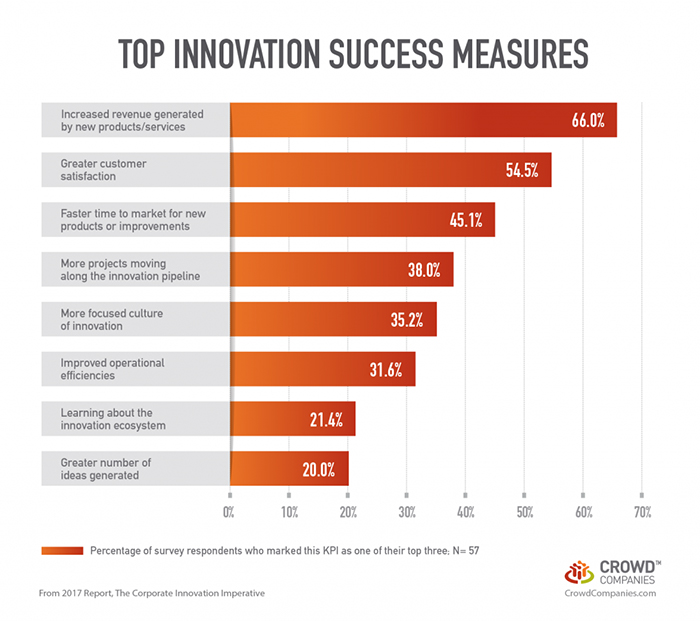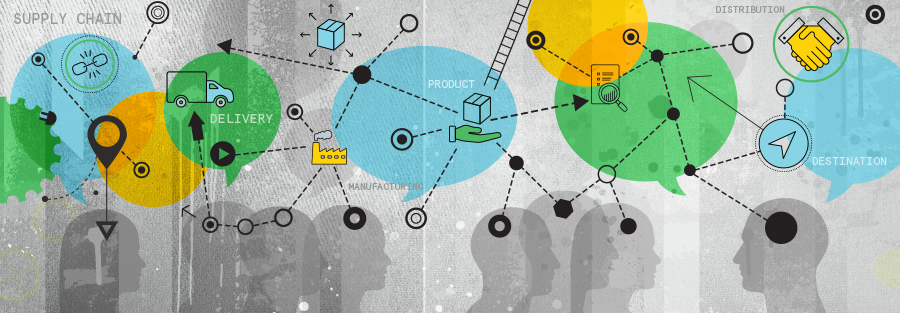From Platitude to Paradigm
Internal crowdsourcing unleashes disruptive capacity of corporate everyman
Listen in on just about any corporate earnings call and you are likely, at some point, to hear a top-level executive offer a folksy acknowledgment of the company’s employees: “it’s our people that make our company what it is,” or “our people are our greatest resource.” Why, then, do so few organization’s give employees throughout the business a genuine chance to participate in developing innovative new products or processes?
A 2016 survey from Harvard Business School of nearly 3,500 people from companies of varying sizes throughout U.S., Canada, the UK, Germany and India found that although employees across all functions felt that innovation was “everybody’s responsibility,” little more than 40 percent of individual contributors felt they were given the money, staff or support needed to conceive and incubate creative, problem-solving solutions.
 Companies that do not endorse innovation throughout the enterprise risk, not only, missing out on a potentially ground-breaking new product or process, but also creating the much more perilous threat of spawning a “dispiriting work environment” that can become “poisonous to productivity,” according to David Sturt and Jordan Rogers, authors of the Harvard study research report. In this issue’s Executive One-on-One, Johannes Giloth, senior vice president, global operations and chief procurement officer at Nokia shares a similar opinion: “I think it is easy to kill [innovative thinking] by putting people in the wrong dimension where that creativity is not appreciated.”
Companies that do not endorse innovation throughout the enterprise risk, not only, missing out on a potentially ground-breaking new product or process, but also creating the much more perilous threat of spawning a “dispiriting work environment” that can become “poisonous to productivity,” according to David Sturt and Jordan Rogers, authors of the Harvard study research report. In this issue’s Executive One-on-One, Johannes Giloth, senior vice president, global operations and chief procurement officer at Nokia shares a similar opinion: “I think it is easy to kill [innovative thinking] by putting people in the wrong dimension where that creativity is not appreciated.”
Companies that do not endorse innovation throughout the enterprise risk spawning a “dispiriting work environment” that can become “poisonous to productivity.
It is no secret that organizations across all industries are facing an innovation imperative, said Jeremiah Owyang, founder of Crowd Companies and author of the Corporate Innovation Imperative Report. “Companies need to think about disrupting themselves.”
Many companies are doing just that, according to a recent Crowd Companies survey, “by first focusing internally on building the right teams, getting governance and processes in place, and educating current and new employees on emerging technologies before spending time and resources on rolling out external programs or investing in the startup scene.”

While it is important for companies to take risks and innovate, Owyang noted that most companies are still in the early stages when it comes to truly integrating innovation. “We see a lot of experimenting, but no real process,” he said. “There are very few companies that we could categorize as advanced, where they are enabling the whole ecosystem to do innovation around them.”
Even with a sincere commitment to transforming their enterprises from a traditional top-down structure to a progressive bottom-up model, things do not always go as planned. One cautionary tale in the tech sector is Qualcomm’s Venture Fest. A detailed accounting of the program’s conception and eventual
breakdown can be found here. The long-story-short version is that the program, while comprehensive, was missing a key ingredient: enterprise-wide buy-in.
“We were prematurely pushing some of the teams in the business units,” related Ricardo Dos Santos, in a UC Berkley blog. Dos Santos, who has since moved on from the company, created Qualcomm’s Venture Fest program. “The ‘elephant in the room’ was that the Venture Fest program didn’t fit smoothly with the BU’s readiness for dealing with unexpected ‘bottom-up’ innovation.” Developing an intrapreneurship program is the “easy part,” Dos Santos noted. “It gets really tough when these projects are launched and have to fight for survival against current corporate business models.”
“The Venture Fest program didn’t fit smoothly with the BU’s readiness for dealing with unexpected ‘bottoms up’ innovation.”

A common theme among the most successful organizational crowdsourcing programs is that they serve as more than just elaborate suggestion boxes. Rather, they embrace what Imaginatik experts Sara Husk and Chris Townsend define as the first principle of innovation, “if innovation is the objective, engagement is the means.” These programs act as internal startup accelerators, giving employees all the opportunity, and responsibility, of turning their idea into an actionable process or marketable product that can generate meaningful return on investment.
Here are a few best practice examples of intrapreneur programs that embody this principle:
Adobe KickBox
Regarded as a “best in class” intrapreneurship program, KickBox was designed to provide Adobe employees with an “innovation-in-a-box” kit, offering a proven innovation process for “discovering new opportunities, validating customer engagement, and evaluating new business potential.” Each red box contains everything Adobe believes an enterprise innovator needs, including: money ($1,000 pre-paid credit card to fund development), instructions (quick reference cards with checklists of actions innovators must complete to advance to the next level), innovation tools (ex: scorecards, frameworks, exercises) and a Starbucks gift card and candy bar (according to Adobe, caffeine and sugar are two of four major food groups for innovators). To date, Adobe reports that is has distributed over 1,000 red boxes to Adobe employees around the world. The KickBox process is available for free download by individuals and organizations under a creative commons, share-alike, attribution license.
Nestle !ngenius
In 2014, Nestle launched its !ngenius internal crowdsourcing campaign within its supply chain organization to encourage innovation by empowering employees to express their “inner genius.” The campaign runs on a global cloud-based technology platform, enabling employees from around the world to collaborate. Nestle management sends out a quarterly “call-to-action” for inputs on a specific supply chain challenge. Since its launch, Nestle reports that more than 15,000 employees from 40 countries have created 1,000+ new ideas. The most promising ideas are then formed into startups, with the originator of the idea serving as “CEO” for the solution. CEOs and their teams create a business model that is tested within the user community to ensure its viability. Eventually, the CEO creates a three-minute pitch that is delivered to the !ngenius board. Successful ideas receive accelerated funding (up to $100,000). Nestle has deployed 10 successful solutions, such as the !nshelf app that enables employees to check product freshness and on-shelf availability in 26 markets around the globe. The !ngenius platform has since been expanded into five additional business communities within Nestle.
Cisco Innovate Everywhere
How much more innovative can a company with 25,000 engineers and more than 19,000 patents be? That’s precisely what Cisco leadership sought to determine with its Innovate Everywhere Challenge. Every one of Cisco’s 72,000-person workforce from 50 countries was encouraged to “team up, disrupt, and innovate,” and every voice was “welcomed, heard, and respected, regardless of grade level, experience or location,” according to the company. Inspired by the Adobe KickBox, Innovate Everywhere participants were provided Adventure Kits with step-by-step guides through the innovation journey. More than 2,000 employees and teams submitted over 1,100 ideas, which were evaluated by a panel of 250 judges and employees, who cast nearly 46,000 votes and made over 4,100 online comments. The winning teams received the tools they needed to implement their ideas, including three months of time-off, $50,000 ($25,000 in seed funds and $25,000 in recognition), and corporate concierge services to help remove roadblocks and provide access to extensive technology resources and mentors. Cisco is also working to expand its mentor network; developing a “My Innovation” program to make it easier for every Cisco employee to explore their disruptive ideas; building end-to-end innovation hubs for all creative ideas; and piloting “innovation rooms” across various Cisco locations.
Related Resources
- Slideshare: The Corporate Innovation Imperative
- Blog: The Return on Innovation Investment for the Enterprise: At Least $50 Million
- Book: The Crowd Within, Crowdsourced Innovation Inside Companies
- Blog: 3 Reasons Great Ideas Get Lost and How to Fix it
- HBR: 4 Things Your Innovation Efforts Shouldn’t Focus On
- Blog: Design Your Intrapreneurship Program For Success
